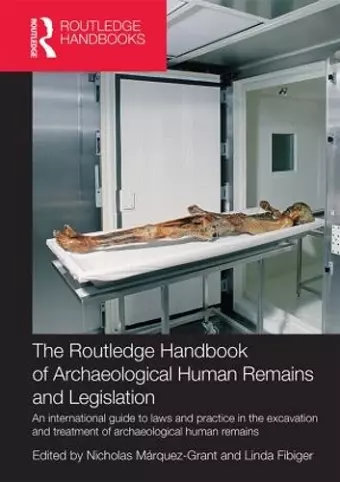The Routledge Handbook of Archaeological Human Remains and Legislation
An international guide to laws and practice in the excavation and treatment of archaeological human remains
Linda Fibiger editor Nicholas Marquez-Grant editor
Format:Paperback
Publisher:Taylor & Francis Ltd
Published:25th Mar '13
Currently unavailable, and unfortunately no date known when it will be back
This paperback is available in another edition too:
- Hardback£230.00(9780415588577)

Methodologies and legislative frameworks regarding the archaeological excavation, retrieval, analysis, curation and potential reburial of human skeletal remains differ throughout the world. As work forces have become increasingly mobile and international research collaborations are steadily increasing, the need for a more comprehensive understanding of different national research traditions, methodologies and legislative structures within the academic and commercial sector of physical anthropology has arisen. The Routledge Handbook of Archaeological Human Remains and Legislation provides comprehensive information on the excavation of archaeological human remains and the law through 62 individual country contributions from Europe, Asia, Africa, North America, South America and Australasia.
More specifically, the volume discusses the following:
- What is the current situation (including a brief history) of physical anthropology in the country?
- What happens on discovering human remains (who is notified, etc.)?
- What is the current legislation regarding the excavation of archaeological human skeletal remains? Is a license needed to excavate human remains? Is there any specific legislation regarding excavation in churchyards? Any specific legislation regarding war graves?
- Are physical anthropologists involved in the excavation process?
- Where is the cut-off point between forensic and archaeological human remains (e.g. 100 years, 50 years, 25 years…)?
- Can human remains be transported abroad for research purposes?
- What methods of anthropological analysis are mostly used in the country? Are there any methods created in that country which are population-specific?
- Are there particular ethical issues that need to be considered when excavating human remains, such as religious groups or tribal groups?
In addition, an overview of landmark anthropological studies and important collections are provided where appropriate.
The entries are contained by an introductory chapter by the editors which establish the objectives and structure of the book, setting it within a wider archaeological framework, and a conclusion which explores the current European and world-wide trends and perspectives in the study of archaeological human remains. The Routledge Handbook of Archaeological Human Remains and Legislation makes a timely, much-needed contribution to the field of physical anthropology and is unique as it combines information on the excavation of human remains and the legislation that guides it, alongside information on the current state of physical anthropology across several continents. It is an indispensible tool...
'This will be an incredibly useful source of information for scholars around the world who are, or may be hoping to be, working with human remains from archaeological contexts in particular places across the globe. It will, furthermore, save much time searching for relevant information to help their work, and provide much needed contacts ... an essential reference text for students working on archaeological human remains.'- Charlotte Roberts, Durham University, UK
ISBN: 9780415859400
Dimensions: unknown
Weight: 1480g
774 pages